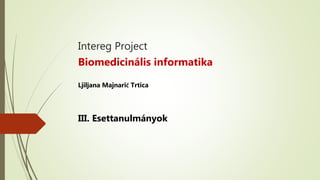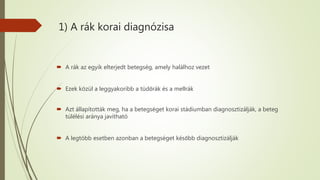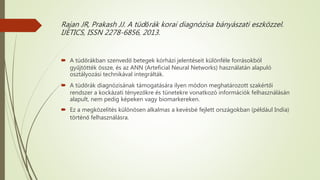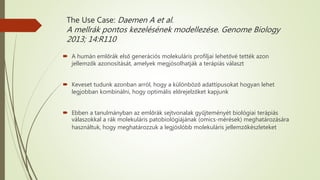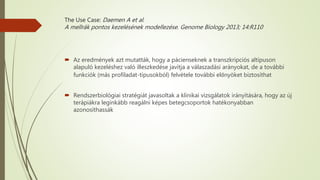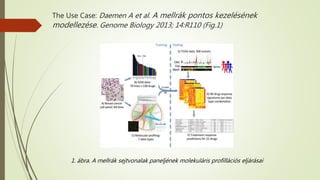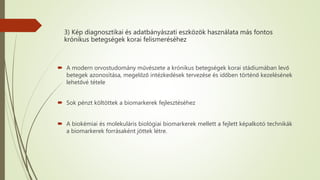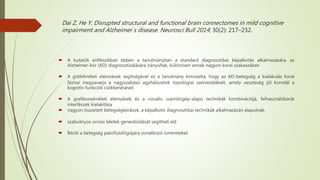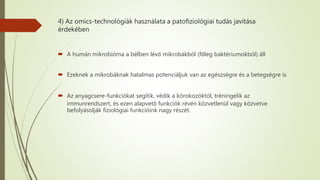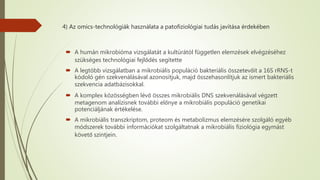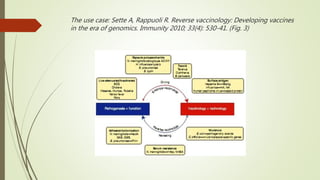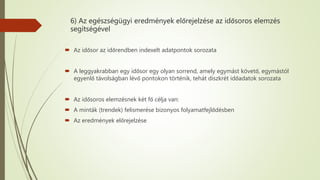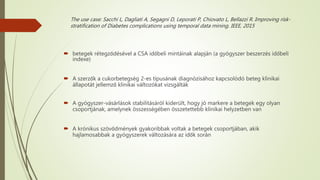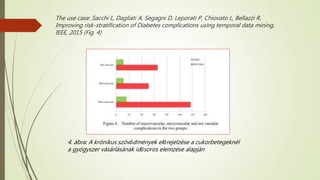∑°≤űĪū≥Ŕ≥Ŕ≤Ļ≤‘≥‹ĪŰ≥ĺ√°≤‘≤‚ī«įž
- 1. Intereg Project Biomedicin√°lis informatika Ljiljana Majnarińá Trtica III. ∑°≤űĪū≥Ŕ≥Ŕ≤Ļ≤‘≥‹ĪŰ≥ĺ√°≤‘≤‚ī«įž
- 2. 1) A r√°k korai diagn√≥zisa Ôāī A r√°k az egyik elterjedt betegs√©g, amely hal√°lhoz vezet Ôāī Ezek k√∂z√ľl a leggyakoribb a t√ľdŇĎr√°k √©s a mellr√°k Ôāī Azt √°llap√≠tott√°k meg, ha a betegs√©get korai st√°diumban diagnosztiz√°lj√°k, a beteg t√ļl√©l√©si ar√°nya jav√≠that√≥ Ôāī A legt√∂bb esetben azonban a betegs√©get k√©sŇĎbb diagnosztiz√°lj√°k
- 3. 1) A r√°k korai diagn√≥zisa Ôāī Hat√©kony szŇĪr√©si m√≥dszer (nagyfelbont√°s√ļ mammogr√°fia) haszn√°lnak az emlŇĎr√°kra c√©lir√°nyos szŇĪr√©s√©re Ôāī Hasonl√≥ m√≥dszer nem l√©tezik a t√ľdŇĎr√°k korai kimutat√°s√°ra Ôāī Ez√©rt a t√ľdŇĎr√°k korai diagn√≥zisa a megfelelŇĎ m√≥dszer a predikt√≠v modellez√©s, amelyet DM √©s ML m√≥dszerekkel v√©geznek.
- 4. Rajan JR, Prakash JJ. A t√ľdŇĎr√°k korai diagn√≥zisa b√°ny√°szati eszk√∂zzel. IJETICS, ISSN 2278-6856, 2013. Ôāī A t√ľdŇĎr√°kban szenvedŇĎ betegek k√≥rh√°zi jelent√©seit k√ľl√∂nf√©le forr√°sokb√≥l gyŇĪjt√∂tt√©k √∂ssze, √©s az ANN (Arteficial Neural Networks) haszn√°lat√°n alapul√≥ oszt√°lyoz√°si technik√°val integr√°lt√°k. Ôāī A t√ľdŇĎr√°k diagn√≥zis√°nak t√°mogat√°s√°ra ilyen m√≥don meghat√°rozott szak√©rtŇĎi rendszer a kock√°zati t√©nyezŇĎkre √©s t√ľnetekre vonatkoz√≥ inform√°ci√≥k felhaszn√°l√°s√°n alapult, nem pedig k√©peken vagy biomarkereken. Ôāī Ez a megk√∂zel√≠t√©s k√ľl√∂n√∂sen alkalmas a kev√©sb√© fejlett orsz√°gokban (p√©ld√°ul India) t√∂rt√©nŇĎ felhaszn√°l√°sra.
- 5. 2) A r√°k gy√≥gyszeres kezel√©sre adott v√°lasz elŇĎrejelz√©se Ôāī A r√°k klinikailag √©s genomi√°lisan heterog√©n betegs√©g Ôāī A gy√≥gyszeripari c√©gek a DM-t nagy mennyis√©gŇĪ genomi√°lis adatra alkalmazz√°k, hogy megj√≥solj√°k, hogyan a gy√≥gyszeres kezel√©sre mik√©nt befoly√°solja p√°ciens reakci√≥j√°t a genetikai profilja alapj√°n.
- 6. The Use Case: Daemen A et al. A mellr√°k pontos kezel√©s√©nek modellez√©se. Genome Biology 2013; 14:R110 Ôāī A hum√°n emlŇĎr√°k elsŇĎ gener√°ci√≥s molekul√°ris profiljai lehetŇĎv√© tett√©k azon jellemzŇĎk azonos√≠t√°s√°t, amelyek megj√≥solhatj√°k a ter√°pi√°s v√°laszt Ôāī Keveset tudunk azonban arr√≥l, hogy a k√ľl√∂nb√∂zŇĎ adatt√≠pusokat hogyan lehet legjobban kombin√°lni, hogy optim√°lis elŇĎrejelzŇĎket kapjunk Ôāī Ebben a tanulm√°nyban az emlŇĎr√°k sejtvonalak gyŇĪjtem√©ny√©t biol√≥giai ter√°pi√°s v√°laszokkal a r√°k molekul√°ris patobiol√≥gi√°j√°nak (omics-m√©r√©sek) meghat√°roz√°s√°ra haszn√°ltuk, hogy meghat√°rozzuk a legj√≥sl√≥bb molekul√°ris jellemzŇĎk√©szleteket
- 7. The Use Case: Daemen A et al. A mellr√°k pontos kezel√©s√©nek modellez√©se. Genome Biology 2013; 14:R110 Ôāī Molekul√°ris profilk√©sz√≠tŇĎ adatk√©szletek: a DNS-m√°solatok sz√°ma, az mRNS- expresszi√≥, a transzkriptom-szekvencia, a promoter-metil√°ci√≥, a feh√©rje-bŇĎs√©g √©s a mut√°ci√≥s √°llapot Ôāī A v√°laszokhoz kapcsol√≥d√≥ molekul√°ris jellemzŇĎk azonos√≠t√°s√°ra a legkisebb n√©gyzetek t√°mogat√≥ vektor g√©peket √©s v√©letlenszerŇĪ erdŇĎ algoritmusokat haszn√°ltunk
- 8. The Use Case: Daemen A et al. A mellr√°k pontos kezel√©s√©nek modellez√©se. Genome Biology 2013; 14:R110 Ôāī Az eredm√©nyek azt mutatt√°k, hogy a p√°cienseknek a transzkripci√≥s alt√≠puson alapul√≥ kezel√©shez val√≥ illeszked√©se jav√≠tja a v√°laszad√°si ar√°nyokat, de a tov√°bbi funkci√≥k (m√°s profiladat-t√≠pusokb√≥l) felv√©tele tov√°bbi elŇĎny√∂ket biztos√≠that Ôāī Rendszerbiol√≥giai strat√©gi√°t javasoltak a klinikai vizsg√°latok ir√°ny√≠t√°s√°ra, hogy az √ļj ter√°pi√°kra legink√°bb reag√°lni k√©pes betegcsoportok hat√©konyabban azonos√≠thass√°k
- 9. The Use Case: Daemen A et al. A mellrák pontos kezelésének modellezése. Genome Biology 2013; 14:R110 (Fig.1) 1. ábra. A mellrák sejtvonalak paneljének molekuláris profillációs eljárásai
- 10. 3) K√©p diagnosztikai √©s adatb√°ny√°szati eszk√∂z√∂k haszn√°lata m√°s fontos kr√≥nikus betegs√©gek korai felismer√©s√©hez Ôāī A modern orvostudom√°ny mŇĪv√©szete a kr√≥nikus betegs√©gek korai st√°dium√°ban levŇĎ betegek azonos√≠t√°sa, megelŇĎzŇĎ int√©zked√©sek tervez√©se √©s idŇĎben t√∂rt√©nŇĎ kezel√©s√©nek lehetŇĎv√© t√©tele Ôāī Sok p√©nzt k√∂lt√∂ttek a biomarkerek fejleszt√©s√©hez Ôāī A biok√©miai √©s molekul√°ris biol√≥giai biomarkerek mellett a fejlett k√©palkot√≥ technik√°k a biomarkerek forr√°sak√©nt j√∂ttek l√©tre.
- 11. Dai Z, He Y. Disrupted structural and functional brain connectomes in mild cognitive impairment and Alzheimer`s disease. Neurosci Bull 2014; 30(2): 217‚Äď232. Ôāī A kutat√≥k erŇĎfesz√≠t√©sei ebben a tanulm√°nyban a standard diagnosztikai k√©palkot√°s alkalmaz√°s√°ra, az Alzheimer-k√≥r (AD) diagnosztiz√°l√°s√°ra ir√°nyultak, k√ľl√∂n√∂sen annak nagyon korai szakasz√°ban Ôāī A gr√°felm√©leti elemz√©sek seg√≠ts√©g√©vel ez a tanulm√°ny kimutatta, hogy az AD-betegs√©g a kialakul√°s korai f√°zisai megzavarja a nagyszab√°s√ļ agyh√°l√≥zatok topol√≥giai szervezŇĎd√©s√©t, amely vesztes√©g j√≥l korrel√°l a kognit√≠v funkci√≥k cs√∂kken√©s√©vel. Ôāī A grafikonelm√©leti elemz√©sek √©s a vizu√°lis sz√°m√≠t√≥g√©p-alap√ļ technik√°k kombin√°ci√≥j√°, felhaszn√°l√≥bar√°t interf√©szek kialak√≠t√°sa Ôāī nagyon √∂sszetett betegs√©gle√≠r√°sok, a k√©palkot√≥ diagnosztikai technik√°k alkalmaz√°s√°n alapulnak, Ôāī szabv√°nyos orvosi leletek gener√°l√≥d√°s√°t seg√≠theti elŇĎ Ôāī BŇĎv√≠ti a betegs√©g patofiziol√≥gi√°j√°ra vonatkoz√≥ ismereteket
- 12. 4) A kr√≥nikus betegs√©gek patofiziol√≥gi√°j√°nak meg√©rt√©s√©nek jav√≠t√°sa az omics - technik√°k seg√≠ts√©g√©vel Ôāī A biotechnol√≥gia √©s a sz√°m√≠t√≥g√©pes technol√≥gi√°k √≥ri√°si elŇĎrehalad√°sa hozz√°j√°rult a t√∂meges adatelemz√©shez az elm√ļlt √©vtizedekben, Ôāī egy√©rtelmŇĪ elŇĎny√∂ket ny√ļjtott az orvosi gyakorlatban Ôāī az eg√©szs√©g√ľgyi ell√°t√°s sz√°mos √°gazat√°ban gyakori a genomika, a proteomika √©s m√°s OMICS-technik√°k alkalmaz√°sa Ôāī Ezen technik√°k alkalmaz√°s√°val sok kr√≥nikus betegs√©g diagnosztiz√°l√°sa j√≥val kor√°bban lehets√©ges, mint kor√°bban Ôāī √©s lehetŇĎv√© v√°lt a molekul√°ris mechanizmusok √©s egy√©b rendelleness√©gek jel√°tviteli √ļtj√°nak megismer√©se - ez m√©g nem volt lehets√©ges Ôāī Az inform√°ci√≥ integr√°ci√≥knak legmagasabb fokozata a rendszerbiol√≥gi√°ban √©s a komplex h√°l√≥zati elemz√©sben, a biol√≥giai szab√°lyoz√≥ h√°l√≥zatok mŇĪk√∂d√©s√©nek felt√°r√°s√°ra ir√°nyul√≥ holisztikus megk√∂zel√≠t√©sekkel √©rhetŇĎ el.
- 13. 4) Az omics-technol√≥gi√°k haszn√°lata a patofiziol√≥giai tud√°s jav√≠t√°sa √©rdek√©ben Ôāī A hum√°n mikrobi√≥ma a b√©lben l√©vŇĎ mikrob√°kb√≥l (fŇĎleg bakt√©riumokb√≥l) √°ll Ôāī Ezeknek a mikrob√°knak hatalmas potenci√°ljuk van az eg√©szs√©gre √©s a betegs√©gre is Ôāī Az anyagcsere-funkci√≥kat seg√≠tik, v√©dik a k√≥rokoz√≥kt√≥l, tr√©ningelik az immunrendszert, √©s ezen alapvetŇĎ funkci√≥k r√©v√©n k√∂zvetlen√ľl vagy k√∂zvetve befoly√°solj√°k fiziol√≥giai funkci√≥ink nagy r√©sz√©t.
- 14. 4) Az omics-technol√≥gi√°k haszn√°lata a patofiziol√≥giai tud√°s jav√≠t√°sa √©rdek√©ben Ôāī A hum√°n mikrobi√≥ma vizsg√°lat√°t a kult√ļr√°t√≥l f√ľggetlen elemz√©sek elv√©gz√©s√©hez sz√ľks√©ges technol√≥giai fejlŇĎd√©s seg√≠tette Ôāī A legt√∂bb vizsg√°latban a mikrobi√°lis popul√°ci√≥ bakteri√°lis √∂sszetevŇĎit a 16S rRNS-t k√≥dol√≥ g√©n szekven√°l√°s√°val azonos√≠tjuk, majd √∂sszehasonl√≠tjuk az ismert bakteri√°lis szekvencia adatb√°zisokkal. Ôāī A komplex k√∂z√∂ss√©gben l√©vŇĎ √∂sszes mikrobi√°lis DNS szekven√°l√°s√°val v√©gzett metagenom anal√≠zisnek tov√°bbi elŇĎnye a mikrobi√°lis popul√°ci√≥ genetikai potenci√°lj√°nak √©rt√©kel√©se. Ôāī A mikrobi√°lis transzkriptom, proteom √©s metabolizmus elemz√©s√©re szolg√°l√≥ egy√©b m√≥dszerek tov√°bbi inform√°ci√≥kat szolg√°ltatnak a mikrobi√°lis fiziol√≥gia egym√°st k√∂vetŇĎ szintjein.
- 15. The Use Case: Qin J, et al. A human microbial gene catalogue established by metagenomic sequencing. Nature 2010; 464(7285): 59-65.(Fig. 2) 2. √°bra: A bakteri√°lis fajok bŇĎs√©ge elk√ľl√∂n√≠ti a gyullad√°sos b√©lbetegs√©gben (fek√©lyes vastagb√©lgyullad√°st √©s Crohn-betegs√©gben) szenvedŇĎket az eg√©szs√©ges szem√©lyektŇĎl
- 16. 5) A vakcin√°k fejlŇĎd√©se Ôāī A 20. sz√°zad v√©g√©n a hagyom√°nyos technol√≥gi√°k haszn√°lat√°n alapul√≥ (a betegs√©geket okoz√≥ v√≠rusok meg√∂l√©s√©vel √©s enyh√≠t√©s√©vel) alapul√≥ vakcin√°k nagy r√©sz√©t m√°r kifejlesztett√©k . Ôāī √öj technol√≥gi√°kra van sz√ľks√©g a fennmarad√≥ olyan k√≥rokoz√≥k legyŇĎz√©s√©hez, melyek rezisztensek maradtak a vakcin√°kra Ôāī Ebben az idŇĎszakban jelentŇĎs elŇĎrel√©p√©s t√∂rt√©nt olyan √ļj technol√≥gi√°k bevezet√©s√©vel, mint a rekombin√°ns DNS √©s a feh√©rj√©k k√©miai konjug√°ci√≥ja a poliszacharidokkal, valamint az √ļj adjuv√°nsok alkalmaz√°s√°nak fejlŇĎd√©se. Ôāī Tov√°bb√° egy erŇĎs eszk√∂z lett a kez√ľnkben att√≥l, hogy a mikroorganizmusok genomjaihoz hozz√° tudunk f√©rni Ôāī Ez a technol√≥giai forradalom elŇĎsz√∂r lehetŇĎv√© tette, hogy a Pasteur szab√°lyain t√ļlmenŇĎen k√©pes legyen a sz√°m√≠t√≥g√©pet racion√°lisan a genomban l√©vŇĎ inform√°ci√≥ alapj√°n vakcin√°t megtervezni, an√©lk√ľl, hogy sz√ľks√©g lenne a specifikus mikroorganizmusok n√∂veked√©s√©re. Ôāī Ez az √ļj megk√∂zel√≠t√©s ‚Äěford√≠tott vakcin√°ci√≥‚ÄĚ volt.
- 17. The use case: Sette A, Rappuoli R. Reverse vaccinology: Developing vaccines in the era of genomics. Immunity 2010; 33(4): 530-41. (Fig. 3)
- 18. The use case: Sette A, Rappuoli R. Reverse vaccinology: Developing vaccines in the era of genomics. Immunity 2010; 33(4): 530-41. Ôāī 3. √°bra le√≠r√°s Ôāī Az elsŇĎ k√≥rokoz√≥ a ford√≠tott vakcin√°ci√≥s megk√∂zel√≠t√©s sor√°n a Meningococcus B (MenB) volt. Ôāī Ez a k√≥rokoz√≥ makacsan ellen√°llt a vakcin√°nak, mert kapszul√°ris poliszacharidja azonos az emberi √∂nantig√©nnel, m√≠g a bakteri√°lis felsz√≠ni feh√©rj√©k rendk√≠v√ľl v√°ltozatosak. Ôāī A hagyom√°nyos technol√≥gi√°kat alkalmaz√≥ vakcina kifejleszt√©s√©re tett sz√°mos k√≠s√©rlet sikertelen maradt Ôāī A projekt a MenB genom szekven√°l√°s√°ra √©s a genom inform√°ci√≥ felhaszn√°l√°sa alapj√°n ir√°nyult a vakcina kifejleszt√©s√©re Ôāī A g√©nszekvenci√°kat elemezt√ľk, √©s t√∂bb mint 600 potenci√°lis antig√©nt vizsg√°ltunk az antigenit√°s szempontj√°b√≥l Ôāī A jel√∂lt szekvenci√°kat Escherichia coli-ban expressz√°ltuk, √©s immuniz√°lt egerekbŇĎl sz√°rmaz√≥ sz√©rumokat kaptunk mindegyik√ľk ellen Ôāī A sz√©rumok elemz√©se t√∂bb mint 90 kor√°bban ismeretlen fel√ľleti feh√©rj√©t t√°rt fel (csak 12 fel√ľleti antig√©n volt ismert, k√∂z√ľl√ľk csak 4-5 bakteri√°lis aktivit√°st mutatott) Ôāī A 90 felfedezett antig√©n k√∂z√ľl 29-en k√©pesek voltak olyan antitesteket induk√°lni, amelyek in vitro meg√∂lhetik a bakt√©riumokat a komplement jelenl√©t√©ben Ôāī A k√∂vetkezŇĎ √©vekben a legjobb √©s legsz√©lesebb baktericid aktivit√°st kiv√°lt√≥ antig√©neket v√°lasztottuk ki √©s helyezt√ľk be protot√≠pus vakcin√°kba, amelyek k√©pesek v√©dŇĎ immunit√°st ind√≠tani a legt√∂bb MenB t√∂rzs ellen egerekben. Ôāī Sikeres preklinikai vizsg√°latok ut√°n a MenB vakcina a vakcina fejleszt√©s√©nek elindult
- 19. 6) Az eg√©szs√©g√ľgyi eredm√©nyek elŇĎrejelz√©se az idŇĎsoros elemz√©s seg√≠ts√©g√©vel Ôāī Az idŇĎsor az idŇĎrendben indexelt adatpontok sorozata Ôāī A leggyakrabban egy idŇĎsor egy olyan sorrend, amely egym√°st k√∂vetŇĎ, egym√°st√≥l egyenlŇĎ t√°vols√°gban l√©vŇĎ pontokon t√∂rt√©nik, teh√°t diszkr√©t idŇĎadatok sorozata Ôāī Az idŇĎsoros elemz√©snek k√©t fŇĎ c√©lja van: Ôāī A mint√°k (trendek) felismer√©se bizonyos folyamatfejlŇĎd√©sben Ôāī Az eredm√©nyek elŇĎrejelz√©se
- 20. The use case: Sacchi L, Dagliati A, Segagni D, Leporati P, Chiovato L, Bellazzi R. Improving risk- stratification of Diabetes complications using temporal data mining. IEEE, 2015 Ôāī betegek r√©tegzŇĎd√©s√©vel a CSA idŇĎbeli mint√°inak alapj√°n (a gy√≥gyszer beszerz√©s idŇĎbeli indexe) Ôāī A szerzŇĎk a cukorbetegs√©g 2-es t√≠pus√°nak diagn√≥zis√°hoz kapcsol√≥d√≥ beteg klinikai √°llapot√°t jellemzŇĎ klinikai v√°ltoz√≥kat vizsg√°lt√°k Ôāī A gy√≥gyszer-v√°s√°rl√°sok stabilit√°s√°r√≥l kider√ľlt, hogy j√≥ markere a betegek egy olyan csoportj√°nak, amelynek √∂sszess√©g√©ben √∂sszetettebb klinikai helyzetben van Ôāī A kr√≥nikus sz√∂vŇĎdm√©nyek gyakoribbak voltak a betegek csoportj√°ban, akik hajlamosabbak a gy√≥gyszerek v√°ltoz√°s√°ra az idŇĎk sor√°n
- 21. The use case: Sacchi L, Dagliati A, Segagni D, Leporati P, Chiovato L, Bellazzi R. Improving risk-stratification of Diabetes complications using temporal data mining. IEEE, 2015 (Fig. 4) 4. √°bra: A kr√≥nikus sz√∂vŇĎdm√©nyek elŇĎrejelz√©se a cukorbetegekn√©l a gy√≥gyszer v√°s√°rl√°s√°nak idŇĎsoros elemz√©se alapj√°n
